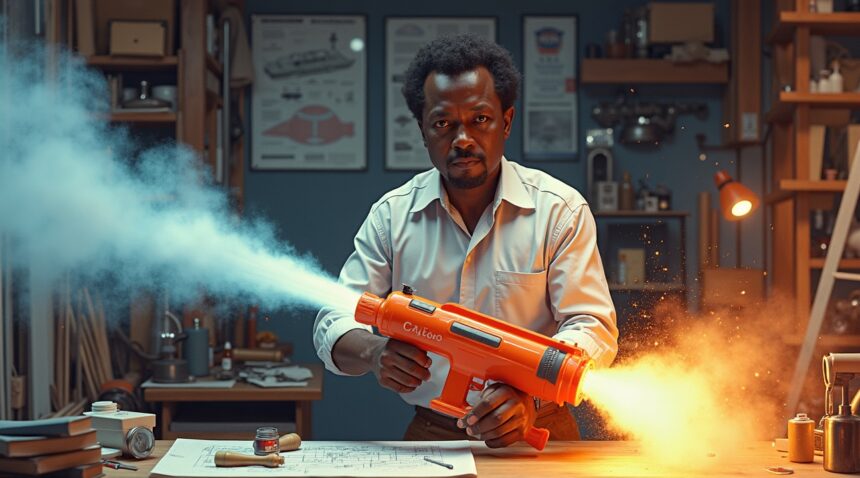Lonnie Johnson, a former NASA nuclear engineer, made an unexpected leap into the toy industry in 1982 with the accidental creation of the Super Soaker, sparking a remarkable journey of innovation, legal battles, and commercial success.
Key Takeaways
- Accidental Discovery: Johnson stumbled upon the Super Soaker concept while testing heat pump technology at his bathroom sink. This led to the invention of a pressurized water delivery mechanism that would transform water gun design.
- Commercial Triumph: Within just two years of launch, the Super Soaker earned over $200 million in sales and eventually amassed nearly $1 billion in total revenue across more than 175 product variations.
- Royalty Agreement with Hasbro: In 1996, Johnson entered a licensing deal with toy giant Hasbro, entitling him to a 2% royalty on three-dimensional products and 1% on two-dimensional uses, covering both Super Soakers and similar Nerf products.
- Legal and Arbitration Victory: Despite receiving royalties through the 1990s, Johnson discovered significant unpaid earnings between 2007 and 2012. He pursued arbitration and in November 2013 was awarded $73 million in unpaid royalties.
- Beyond Toys: Johnson used the revenue and recognition from the Super Soaker to build a diverse patent portfolio, including over 80 patents related to toy innovations, energy systems, and battery technology.
For more on Lonnie Johnson’s innovative work and legacy, you can visit the official site of the Johnson Research and Development Company.
NASA Engineer’s Accidental Discovery Led to Billion-Dollar Toy Empire
The story of the Super Soaker begins with Lonnie G. Johnson, Ph.D., a brilliant nuclear engineer whose work at NASA would accidentally create one of the most successful toy inventions in history. Johnson, a graduate of Tuskegee University, was conducting experiments on heat pump technology in 1982 when serendipity struck in his bathroom.
From Space Missions to Backyard Water Wars
Johnson’s impressive career credentials made his accidental invention even more remarkable. At the time of his discovery, he was working at NASA’s Jet Propulsion Laboratory, contributing to some of the most ambitious space missions ever conceived. His expertise extended across multiple high-profile projects, including the Galileo mission to Jupiter, the Mars Observer project, and design contributions to the Cassini probe to Saturn.
The nuclear engineer was testing a new type of heat pump that used water instead of conventional coolants when he attached a homemade nozzle to his bathroom sink. Water shot across the room with surprising force, creating what would become the foundation for a billion-dollar toy empire. This unexpected moment transformed Johnson from a space technology specialist into an unlikely toy inventor.
The Accidental Breakthrough That Changed Summer Fun
Johnson’s heat pump experiments involved pressurized water systems, which inadvertently created the perfect mechanism for a revolutionary water gun. The powerful stream that emerged during his testing demonstrated capabilities far beyond traditional squirt guns available at the time. Much like how SpaceX launch marks a new era in aerospace innovation, Johnson’s accidental discovery would revolutionize children’s outdoor play.
The engineer recognized the commercial potential immediately and began developing prototypes in his spare time. Working from his home workshop, Johnson refined the design that would eventually become the Super Soaker. His background in aerospace engineering proved invaluable in perfecting the pressure mechanisms and water delivery systems that made the toy so effective.
Johnson’s invention process involved applying the same rigorous scientific principles he used in his NASA work to create a consumer product. The pressurized air chamber system he developed could propel water streams up to 50 feet, dramatically outperforming existing water toys on the market. This innovation would eventually lead to sales exceeding $200 million annually at its peak.
The transition from accidental discovery to commercial product wasn’t immediate. Johnson spent years perfecting his design while maintaining his demanding career at NASA. His dual expertise in both nuclear engineering and practical problem-solving enabled him to overcome the technical challenges of creating a safe, effective, and manufacturable water gun.
The Super Soaker’s success story demonstrates how scientific expertise can translate into unexpected commercial success. Johnson’s work on complex space missions provided him with the technical foundation needed to understand pressure dynamics, fluid mechanics, and materials science—all crucial elements in creating his revolutionary water gun.
His invention process also highlights the importance of recognizing opportunity when it presents itself. While many might have dismissed the powerful water stream as merely an interesting side effect of their heat pump research, Johnson saw its potential to transform an entire product category. This vision, combined with his technical expertise, created the foundation for what would become one of the most successful toy franchises in history.
The success of the Super Soaker would eventually lead to complex legal battles over royalties and patent rights, but the origin story remains a testament to how accidental discoveries can reshape entire industries. Johnson’s background as a NASA engineer working on cutting-edge space technology provided the perfect foundation for creating a toy that would dominate summer play for generations to come.

Super Soaker Becomes Unstoppable Commercial Phenomenon
I witnessed one of the most extraordinary licensing success stories in toy history when Lonnie Johnson partnered with the Larami Corporation in 1989. Johnson’s decision to license his Super Soaker technology rather than manufacture it himself proved brilliant, as Larami possessed the distribution networks and marketing expertise needed to transform his invention into a global sensation.
The Super Soaker’s commercial impact was immediate and staggering. Within its first two years on the market, the revolutionary water gun generated over $200 million in retail sales, completely reshaping consumer expectations for summer toys. This explosive start signaled that Johnson had created something far beyond a simple improvement to existing water guns.
Record-Breaking Sales Performance
The numbers tell an incredible story of sustained commercial success. During the first decade alone, manufacturers sold more than 200 million Super Soaker units worldwide. This achievement becomes even more impressive when considering how companies build billion-dollar valuations through innovative products that capture mass market appeal.
The product line’s expansion strategy proved equally successful. Manufacturers developed more than 175 different Super Soaker variations, each targeting specific age groups, price points, and performance preferences. This diversification approach helped maintain consumer interest while maximizing market penetration across demographic segments.
Cultural Impact and Industry Recognition
By the time Hasbro acquired Larami Corporation, the Super Soaker had fundamentally transformed the water gun market. Traditional squeeze-trigger models became obsolete almost overnight as consumers embraced the superior range and power of Johnson’s pressure-based system. The toy’s influence extended beyond mere sales figures, creating new categories of outdoor play and summer entertainment.
Overall Super Soaker sales approached the remarkable $1 billion milestone, cementing its status as one of the most successful toy launches in modern history. This financial success attracted attention from industry observers who recognized the product’s unique combination of scientific innovation and mass appeal. The National Toy Hall of Fame eventually inducted the Super Soaker, acknowledging its lasting impact on both toy design and childhood recreation.
The Super Soaker phenomenon demonstrated how breakthrough engineering could create entirely new market categories. Johnson’s pressurized water delivery system didn’t simply compete with existing products—it made them obsolete while establishing performance standards that competitors struggled to match. This technological advantage, combined with effective licensing and marketing, transformed a NASA engineer’s weekend project into one of the most recognizable toys of the late 20th century.

The Contract That Sparked a Multimillion-Dollar Battle
I’ll examine the pivotal 1996 agreement that transformed Johnson’s Super Soaker invention into a legal battlefield worth tens of millions. The contract Hasbro signed with Johnson established a straightforward royalty structure that would later prove more complex than either party anticipated.
Contract Terms and Scope
The royalty agreement outlined specific payment percentages that seemed reasonable at the time. Johnson secured a 2 percent royalty rate for all three-dimensional Super Soaker products and a 1 percent rate for two-dimensional representations. These percentages applied not only to the original water blaster but extended to cover similar-looking variations and derivative products.
Hasbro’s decision to include visual derivatives in the contract scope created unforeseen complications. The agreement encompassed toys from Hasbro’s Nerf line, particularly the N-Strike and Dart Tag series, which shared design elements with Johnson’s original concept. This broad coverage meant that products bearing resemblance to the Super Soaker’s distinctive aesthetic would trigger royalty payments.
The contract’s language around “similar-looking variations” became the foundation for future disputes. Johnson’s legal team argued that numerous Netflix prices increases pale in comparison to the revenue Hasbro generated from products covered under this agreement. The N-Strike series alone generated substantial sales, with each unit potentially subject to the royalty terms.
Years passed before the true financial impact became clear. Hasbro’s interpretation of which products fell under the contract differed significantly from Johnson’s understanding. The company classified certain items as exempt from royalty payments, while Johnson maintained they clearly resembled his patented design.
The breach of contract allegations centered on Hasbro’s failure to properly account for and pay royalties on qualifying products. Johnson claimed the toy giant systematically underpaid him by misclassifying products that should have triggered the established royalty rates. This disagreement persisted for years before reaching the courts.
Contract terms that initially appeared straightforward proved anything but simple in practice. The visual similarity clause created gray areas that both parties interpreted differently, setting the stage for a legal battle that would ultimately require judicial intervention to resolve. SpaceX launch innovations demonstrate how intellectual property disputes can span decades, much like Johnson’s protracted fight for fair compensation.
Two Decades of Legal Warfare Over Unpaid Royalties
The legal battle between Lonnie Johnson and toy giant Hasbro stretched across nearly two decades, beginning with an initial lawsuit in 1995. Johnson’s first attempt to secure proper compensation resulted in a settlement in 1997, but this wouldn’t be the end of his fight for fair payment.
The Return to Court in 2013
Johnson discovered something troubling in 2013 that would reignite his legal battle. After reviewing Hasbro’s records, he uncovered evidence of unpaid royalties spanning from 2007 to 2012. This discovery prompted him to file a new lawsuit for breach of contract, alleging that Hasbro had failed to compensate him properly for both Super Soaker and Nerf product sales during this five-year period.
The case highlighted how complex licensing agreements can become, especially when dealing with products that continue generating revenue years after their initial launch. Johnson’s legal team argued that Hasbro had systematically underpaid royalties, violating their contractual obligations established in earlier agreements.
Arbitration Victory and Record-Breaking Award
Rather than proceeding through traditional court channels, the dispute went to arbitration. This process proved highly favorable for Johnson, as the arbitrator’s ruling in November 2013 was completely in his favor according to his legal representatives.
The arbitration concluded with a stunning $72.9 million award, commonly rounded to $73 million in unpaid royalties. This massive settlement represented one of the largest individual inventor payouts in toy industry history. The ruling validated Johnson’s claims that Hasbro had systematically failed to honor their royalty obligations over the disputed five-year period.
The arbitrator’s decision sent shockwaves through the toy industry, demonstrating that even major corporations like Hasbro aren’t immune to accountability when it comes to honoring inventor agreements. Johnson’s persistence in pursuing this legal dispute proved that inventors can successfully challenge large corporations when armed with solid evidence and determination.
This legal victory also highlighted the importance of thorough record-keeping and contract review for inventors working with major manufacturers. Johnson’s ability to identify the unpaid royalties years after the fact underscored how licensing agreements require ongoing monitoring and enforcement.
The $73 million award represented more than just financial compensation – it served as validation for an inventor who had revolutionized water play but struggled for years to receive fair payment for his groundbreaking creation. Much like how major companies must navigate complex financial agreements, toy inventors face similar challenges in protecting their intellectual property rights.
Johnson’s legal warfare demonstrates that even when dealing with entertainment giants, persistence and proper legal representation can lead to justice. The case also showed how arbitration can provide a more efficient path to resolution than prolonged court battles, though the process still took months to reach its favorable conclusion.
The timing of this victory was particularly significant, coming more than two decades after Johnson first invented the Super Soaker. His willingness to continue fighting for proper compensation, even after an initial settlement, proved that inventors shouldn’t accept inadequate payment for transformative innovations that generate substantial ongoing revenue for manufacturers.

From Water Guns to Patent Empire and Beyond
Lonnie Johnson’s success with the Super Soaker opened doors to building an impressive intellectual property empire that extends far beyond toy manufacturing. His portfolio currently includes over 80 patents with more than 20 additional applications pending, demonstrating the breadth of his innovative thinking across multiple industries.
The foundation technology behind the Super Soaker became a launching pad for numerous related patents that improved water delivery systems, pressure mechanisms, and fluid dynamics applications. Johnson didn’t stop there – he strategically expanded into energy conversion technologies and advanced battery systems, recognizing the commercial potential of his engineering expertise. These innovations represent a natural evolution from his mechanical engineering background and show how inventors can leverage initial successes into broader technological ventures.
Strategic Patent Portfolio Development
Johnson’s approach to patent protection illustrates several key strategies that inventors should consider when building their intellectual property portfolios:
- File comprehensive patent applications that cover core technology and potential variations
- Protect incremental improvements and modifications to existing designs
- Expand patent coverage into related industries and applications
- Maintain active patent prosecution with pending applications for ongoing innovations
- License patents strategically to maximize revenue while retaining control over key technologies
The financial windfall from his $73 million settlement provided Johnson with the capital needed to fund his energy-focused ventures. He established companies dedicated to developing next-generation battery technologies and energy conversion systems, areas where his engineering skills could address significant market needs. This diversification strategy demonstrates how successful inventors can reinvest profits from one innovation to fuel development in emerging technological sectors.
Johnson’s experience highlights the critical importance of proper licensing agreements and patent protection for inventors. His lengthy legal battle with Hasbro underscores why inventors must carefully structure their licensing deals and maintain strong legal counsel throughout the commercialization process. The toy industry impact of the Super Soaker continues to influence water gun designs today, with many manufacturers still referencing Johnson’s original pressure-based technology.
The entrepreneurial journey from a single toy invention to a diverse technology portfolio shows how innovative thinking can transcend industry boundaries. Johnson’s work in battery technology and energy conversion represents potentially game-changing applications that could influence everything from space exploration to consumer electronics. His approach demonstrates that successful innovation requires not just technical expertise but also strategic business thinking and persistence in protecting intellectual property rights.
Modern inventors can learn from Johnson’s experience by understanding that patent protection serves as both a defensive tool and a foundation for future business opportunities. The lengthy timeline between his initial invention and final settlement also illustrates why inventors need patience and determination when pursuing royalty claims against large corporations. Companies like NVIDIA have shown how building strong patent portfolios can create substantial value, though the path isn’t always straightforward.
Johnson’s story reveals how innovation and entrepreneurship intersect with legal strategy and business development. His transition from NASA engineer to toy inventor to energy entrepreneur showcases the potential for technical professionals to create lasting impact across multiple industries. The Super Soaker’s enduring popularity continues to generate revenue while his newer ventures in energy technology position him at the forefront of next-generation power solutions.
The lesson for aspiring inventors lies in understanding that successful innovation requires comprehensive planning that includes patent strategy, licensing negotiations, and long-term business development. Johnson’s experience proves that protecting intellectual property isn’t just about preventing others from copying ideas – it’s about creating a foundation for sustained innovation and business growth across multiple technological domains.

Sources:
Courthouse News Service — “Super Soaker Inventor Demands Royalties”
Cohen IP Law Group — “Super Soaker Settlement $73 Million”
Atlanta Journal-Constitution — “Super Soaker creator awarded $72.9M from Hasbro”
Small Business Trends — “Super Soaker Entrepreneur Fought for $72.9 Million in Hasbro”
Cracked — “Hasbro Screwed The Super Soaker’s Inventor Out Of Millions”
Interesting Engineering — “Lonnie Johnson, The Former NASA Engineer Behind The Super Soaker”


